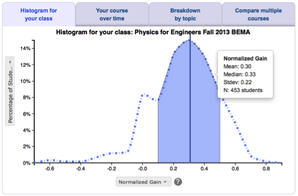SCALE-UP
Where did it come from?
SCALE-UP was developed by Bob Beichner at North Carolina State University (NCSU) in order create a better way to teach large classes. In 1993 NCSU started a project called IMPEC (Integrated Math, Physics, Engineering, and Chemistry) that integrated physics, chemistry, mathematics, and introductory engineering science into an experimental one-year sequence of studio courses. The IMPEC classes were highly successful in minimizing attrition, improving student understanding of the course material, and providing a positive learning experience for 36 students per year, but the project was suspended because it was impractical to expand the program to more than a small fraction of the thousands of students entering the NCSU Engineering program each year. The SCALE-UP project was started to apply the lessons learned from smaller studio classes to “scale up” studio instruction to a size that would be viable at large universities. The project’s main goal is to develop techniques and materials that permit use of research-based pedagogies in large-enrollment studio classes of up to 100 students, even though many of these materials were originally created for small class settings.
In developing SCALE-UP, Beichner and colleagues experimented with many different sizes and shapes of tables before settling on the 7-foot round tables that work best for large classes:

10-foot round tables

long rectangular tables

6-foot round tables

7-foot round tables

SCALE-UP started as an approach for undergraduate physics classes at NCSU, but is now used in many different disciplines at hundreds of colleges and high schools throughout the world. SCALE-UP initially stood for Student-Centered Activities for Large Enrollment University Physics. When it expanded beyond physics, the name changed to Student-Centered Activities for Large Enrollment Undergraduate Programs. When it expanded beyond large enrollment classes, the name changed to Student-Centered Active Learning Environment for Undergraduate Programs. When it expanded beyond undergraduate programs to high school, the name changed again to Student-Centered Active Learning Environment with Upside-down Pedagogies.




